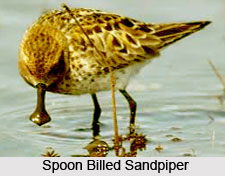 Spoon-Billed Sandpiper is an Indian Bird that bears a scientific name of "Calidris pygmaea". It is a small wader bird that breeds in north-eastern Russia and winters in Southeast Asia.
Spoon-Billed Sandpiper is an Indian Bird that bears a scientific name of "Calidris pygmaea". It is a small wader bird that breeds in north-eastern Russia and winters in Southeast Asia.
Description of Spoon-Billed Sandpiper
Spoon-Billed Sandpiper was first described by Linnaeus in his Systema Naturae in the year 1758. It was later moved to Eurynorhynchus by Sven Nilsson in 1821. It is now classified under the calidrid sandpipers.
Features of Spoon-Billed Sandpiper
The most distinctive feature of Spoon-Billed Sandpiper is its spatulate bill. The breeding adult bird is 14 to 16 centimeters in length, and has a red-brown head, neck and breast with dark brown streaks. It has blackish upperparts with buff and pale rufous fringing. Non-breeding adults lack the reddish colouration, but have pale brownish-grey upperparts with whitish fringing to the wing-coverts. The underparts are white and the legs are black.
Measurement of Spoon-Billed Sandpiper
The measurement of Spoon-Billed Sandpiper are wing 98-106 mm, bill 19-24 mm, bill tip breadth 10-12 mm, tarsus 19-22 mm and tail 37-39 mm.
Breeding of Spoon-Billed Sandpiper
The breeding habitat of Spoon-Billed Sandpiper is sea coasts and adjacent hinterland on the Chukchi Peninsula and southwards along the isthmus of the Kamchatka peninsula
Migration of Spoon-Billed Sandpiper
Spoon-Billed Sandpiper migrates down the Pacific coast through Japan, North Korea, South Korea and China, to its main wintering grounds in South and South-East Asia, where it has been recorded from India, Bangladesh, Sri Lanka, Burma, Thailand, Vietnam, the Philippines, Peninsular Malaysia and Singapore.
Spoon-Billed Sandpiper as Endangered Species
Spoon-Billed Sandpiper is critically endangered, with a current population of fewer than 2500 - probably fewer than 1000 - mature individuals. The main threats to its survival are habitat loss on its breeding grounds and loss of tidal flats through its migratory and wintering range. The important staging area at Saemangeum, South Korea, has already been partially reclaimed, and the remaining wetlands are under serious threat of reclamation in the near future. The protected areas of Spoon-Billed Sandpiper in its staging and wintering areas include Yancheng in China, Mai Po Marshes in Hong Kong and Point Calimere (Point Calimere Sanctuary, Tamil Nadu) and Chilka Lake in Odisha.



















